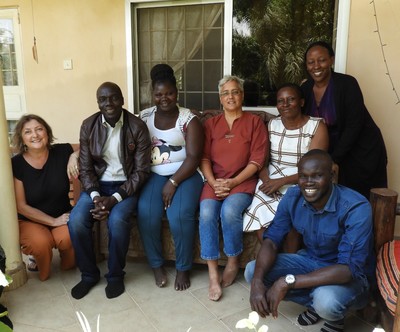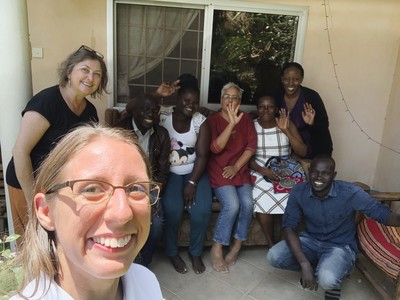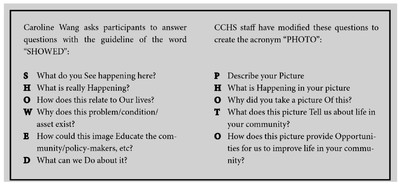
Blog: Photovoice and Palliative Care: Expanding Research in Adjumani and Obongi
![]() Hannah Ikong
Hannah Ikong
![]() 10th November 2022
10th November 2022
We are eager to incorporate Photovoice into the Transform Project in the Adjumani and Obongi districts of Uganda. Photovoice adds a deeper layer to the current data collection, helping us to better understand the lived experiences of severe health-related suffering (SHS) whilst staying in fragile communities. Photovoice is rather new in palliative care research in Africa, but on 22nd August we were able to receive a refresher training from Dr Jane Bates who utilised Photovoice with patients and their families and caregivers in Malawi.
What is Photovoice exactly? Perhaps we can first tell you what it is not: Photovoice is not when a medical researcher visits a new area, evaluates a patient while taking pictures of the setting, then shares a story of what they found. Rather Photovoice is a dialogue where the patients (and/or families and caregivers) use photography to express themselves and share what is most important to them. Photovoice is a great addition to advocacy and self-representation, for it allows the community to speak for themselves by removing the newcomer’s perspective in the storytelling. Dr Jane Bates includes the three goals of Photovoice in her article, Enhanced patient research participation: a Photovoice study in Blantyre Malawi:
1. To enable people to record and reflect their communities’ strengths and concerns.
2. To promote critical dialogue and knowledge about important issues through large and small group discussion of photographs.
3. To reach policymakers.
During the refresher training, Dr Jane Bates spoke about her experiences of using Photovoice among patients with palliative care needs and their families and caregivers. As palliative care, in itself, has a patient-centred approach, it was thought best to use this participatory method of research, allowing those being ‘researched’ in Malawi to become the ‘researcher.’ Conducting the study at a community-based palliative clinic, they recruited six patients and seven carers as co-researchers during a period of four months. Their co-researchers were given digital cameras and through some nine group sessions, they took pictures, selected, and analysed their printed photos, later captioning a few of them in their own words. This process was reported to aid in open dialogue and, at times, assist in clinical review. The third goal of reaching policymakers through Photovoice was achieved at the end of study when they held a photo exhibition and advocacy event, which was attended by the local leaders and media.
Dr Jane Bates also discussed some cautions or concerns raised from their Photovoice study. For instance, this method of research excluded some patients with severe palliative care needs who could either not attend the sessions or see the pictures well. For others who were able to work, the structure of the group meetings was a challenge and they ended up missing some sessions as they needed to work and provide for themselves.
She challenged the leaders of the Transform Project to consider how we could bring Photovoice to Adjamani and Obongi districts, and how we could accommodate those who are more seriously ill and those who need time to work and make a livelihood. We then discussed our proposed research structure that may mitigate these challenges. For one, the trained Village Health Team members (VHTs) carry a smartphone with a camera, so they would work with the patients and their families individually to take photos, select and analyse them. VHTs also do travel to a patient’s home, giving those who are immobile an opportunity to participate and have a voice. Ideally, our VHTs could also liaise with those who are working outside the home and find times to meet and share in the Photovoice research.
It is clear to the Transform Project leaders that Photovoice is a necessary addition in our data collection. We already have the backbone needed for this participatory research method; the VHTs hold smartphones and have been trained how to use the camera, we have a network of patients, families and other caregivers visited regularly by the VHTs, and now our leadership team has been trained in Photovoice methods and the process. The next step will be sharing what we have learned with the VHTs so they can begin the Photovoice process.
Liz Nabirye, clinical lead of PcERC and a part of the Transform leadership found the training applicable to more than just our research in Adjumani and Obongi districts. “To me,” she said, “it is not just a methodology to use for this project, but to train our volunteers in the Kampala Hospitals to learn to use Photovoice and engage with our patients and our families. Photovoice is a strong method of getting quality, important information … [we can] work with the patients and their families and make meaning of the photos and what they are communicating to us.” We thank Dr Jane Bates for the invaluable mentorship she has given the team by sharing her own experiences and advising us in integrating Photovoice to our current research. Do stay tuned for more Photovoice updates, coming soon from Uganda!

Transform Project leaders pose for a photo with Dr Jane Bates. Pictured from left to right: Dr Mhoira Leng, Toko Friday Santiago, Immaculate Atim, Dr Jane Bates, Liz Nabirye, Dr Liz Namukwaya, and Godfrey Oziti.

Selfie time with the author of this blog, Hannah Ikong.

Discussion questions for Photovoice dialogue shared by Dr Jane Bates. We walked through each question and even participated in role plays to see how “SHOWED” and “PHOTO” questions could facilitate deeper discussions.
